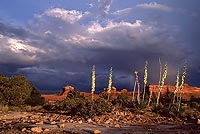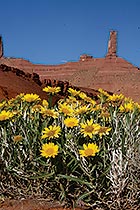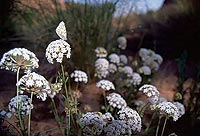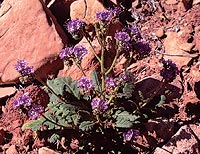Winter is a short season in Canyon Country and by March a few wildflowers have already begun to poke their heads up. That is a welcoming sign that spring is about to unfold upon the desert.
There used to be a competition among the botanically-minded staff of the state’s national parks to report the first wildflower of the season. Bragging rights were the reward, but in reality, it was watching the floral spark that ignited a new cycle of life that was the real prize.
 The botanist from Zion would often win because of lower elevations, warmer temperatures, and a keen eye. So which flower was first? Often it was one of the Lomatium or Biscuitroots, members of the Carrot family, which would send up exploratory flower heads just before the leaves began to emerge. The flowering stems might be short, stunted if cold weather returned, then elongate as the temperatures would rise. The tiny flowers would be arranged in an umbel, sort of like an upside-down umbrella, forming a perfect landing pattern for early insects such as flies that would hatch out as the ground warmed and fly low to feed on nectar or pollen produced by the plants.
The botanist from Zion would often win because of lower elevations, warmer temperatures, and a keen eye. So which flower was first? Often it was one of the Lomatium or Biscuitroots, members of the Carrot family, which would send up exploratory flower heads just before the leaves began to emerge. The flowering stems might be short, stunted if cold weather returned, then elongate as the temperatures would rise. The tiny flowers would be arranged in an umbel, sort of like an upside-down umbrella, forming a perfect landing pattern for early insects such as flies that would hatch out as the ground warmed and fly low to feed on nectar or pollen produced by the plants.
Once the biscuitroots were up, the floral flood gates would open. Following their lead, members in the Mustard family, the Brassicaceae, would also send up short flowering stalks bearing yellow flowers shaped in the pattern of a cross. These would be the Twinpods, members of the Physalis genus, and the flowers would eventually form inflated seed pods joined together at the proverbial  floral hip. Low growing, like many of the first flowers, these
Soon to follow were members of the Pea family, members of the Astragalus genus with purplish-blue pea-shaped flowers and leaves with stiff hairs to protect the foliage from herbivores. Members of this group are also known as “Locoweeds” after the toxin swainsonine (formerly locoine) that, if livestock consume too much of, makes them go loco…but don’t you try it.
floral hip. Low growing, like many of the first flowers, these
Soon to follow were members of the Pea family, members of the Astragalus genus with purplish-blue pea-shaped flowers and leaves with stiff hairs to protect the foliage from herbivores. Members of this group are also known as “Locoweeds” after the toxin swainsonine (formerly locoine) that, if livestock consume too much of, makes them go loco…but don’t you try it.
As the season rolls on into April and May, more wildflowers will appear. Many of these wildflowers are annuals which race through their life cycle to set seeds before the desiccating dryness of summer approaches. The seeds also have an amazing ability to remain dormant in the soil for years, awaiting just the right conditions before they bloom. Some years, when winter moisture is above average, the resultant blooming season may be spectacular...or even better than that!
 The many forms and colors of the spring wildflower season add another dimension to this already spectacular landscape. Keep an eye out for the state’s official wildflower, the Sego lily, with its creamy-white petals and cup-shaped corolla. These plants have edible bulbs that sustained early pioneers and Native Americans. You are kindly discouraged from digging them up; leave them to the bees, please.
The many forms and colors of the spring wildflower season add another dimension to this already spectacular landscape. Keep an eye out for the state’s official wildflower, the Sego lily, with its creamy-white petals and cup-shaped corolla. These plants have edible bulbs that sustained early pioneers and Native Americans. You are kindly discouraged from digging them up; leave them to the bees, please.
In addition to the lilies, there may be fields of yellow bee plants, splashes of red paintbrush, and carpets of evening primroses. The primroses, which generally open later in the day, attract night flying insects such as hawk moths and sphynx moths as pollinators. Of course, an occasional pronghorn might also decide to lie down in a field of flowers and nosh a few.
The reminder to “Stop and smell the flowers” is a good one, just remember to look twice before sticking your nose in too far…you might not “beelieve” who’s in there!

 The botanist from Zion would often win because of lower elevations, warmer temperatures, and a keen eye. So which flower was first? Often it was one of the Lomatium or Biscuitroots, members of the Carrot family, which would send up exploratory flower heads just before the leaves began to emerge. The flowering stems might be short, stunted if cold weather returned, then elongate as the temperatures would rise. The tiny flowers would be arranged in an umbel, sort of like an upside-down umbrella, forming a perfect landing pattern for early insects such as flies that would hatch out as the ground warmed and fly low to feed on nectar or pollen produced by the plants.
The botanist from Zion would often win because of lower elevations, warmer temperatures, and a keen eye. So which flower was first? Often it was one of the Lomatium or Biscuitroots, members of the Carrot family, which would send up exploratory flower heads just before the leaves began to emerge. The flowering stems might be short, stunted if cold weather returned, then elongate as the temperatures would rise. The tiny flowers would be arranged in an umbel, sort of like an upside-down umbrella, forming a perfect landing pattern for early insects such as flies that would hatch out as the ground warmed and fly low to feed on nectar or pollen produced by the plants. floral hip. Low growing, like many of the first flowers, these
Soon to follow were members of the Pea family, members of the Astragalus genus with purplish-blue pea-shaped flowers and leaves with stiff hairs to protect the foliage from herbivores. Members of this group are also known as “Locoweeds” after the toxin swainsonine (formerly locoine) that, if livestock consume too much of, makes them go loco…but don’t you try it.
floral hip. Low growing, like many of the first flowers, these
Soon to follow were members of the Pea family, members of the Astragalus genus with purplish-blue pea-shaped flowers and leaves with stiff hairs to protect the foliage from herbivores. Members of this group are also known as “Locoweeds” after the toxin swainsonine (formerly locoine) that, if livestock consume too much of, makes them go loco…but don’t you try it. The many forms and colors of the spring wildflower season add another dimension to this already spectacular landscape. Keep an eye out for the state’s official wildflower, the Sego lily, with its creamy-white petals and cup-shaped corolla. These plants have edible bulbs that sustained early pioneers and Native Americans. You are kindly discouraged from digging them up; leave them to the bees, please.
The many forms and colors of the spring wildflower season add another dimension to this already spectacular landscape. Keep an eye out for the state’s official wildflower, the Sego lily, with its creamy-white petals and cup-shaped corolla. These plants have edible bulbs that sustained early pioneers and Native Americans. You are kindly discouraged from digging them up; leave them to the bees, please. A natural history writer.
A natural history writer.